Rules to Build Genograms
Although there is general agreement on the basic genogram structure and
symbols, there are some variations from one author to another. Some authors
do reuse the same symbol for different situations while others have ignored
such special cases. GenoPro did a meticulous research to determine what
symbols and rules are best to create coherent genograms.
If you understand the following rules, you will be able create the most
complex genogram without any problem... and others will be able to
understand your work.
Basic Genogram Symbols
 Male & Female symbols
Male & Female symbols
The male is noted by a square and the female by a circle. A family is shown
by an horizontal line connecting the two.
The children are placed below the family line from the oldest to the
youngest, left to right. Although this may sound obvious, it will be very
important to remember these rules when the situation becomes a bit more
complex.
The following case is a husband with three spouses. The husband had three
children with the first wife, then divorced. The husband married the second
wife, had one child and separated. The husband currently lives with another
woman. As you can see, the oldest child is at the left, and the youngest
child, "Half Sister", is at the right of her family, as she is
the only child of the husband and the second wife.
 A Husband with Multiple Spouses
A Husband with Multiple Spouses
Reversing the scenario where the wife had multiple husbands, we get the
following genogram:
 A Wife with Multiple Husbands
A Wife with Multiple Husbands
The second scenario is the same as the first one, except the female spouse
had three husbands. She had three children with her first husband and
divorced. The wife married another man, had one child with him and now lives
with someone else. Please notice the oldest child is always at the left most
position of the family of his biological parents. In this scenario, the
"Oldest Brother" is older than the twins and the half sister, however the
half-sister must be placed under the family of her biological parents. Since
the second marriage is after the first marriage, it follows that the half
sister is younger than the children from the first marriage. The half
sister therefore appears to the left, although she is not the oldest child.
If you are confused, please read this paragraph again.
In summary, here are the
four rules to build a genogram:
- The male parent is always at the left of the family and the female
parent is always at the right of the family.
- In the case of ambiguity, assume a male-female relationship, rather than
male-male or female-female relationship.
- A spouse must always be closer to his/her first partner, then the second
partner (if any), third partner, and so on...
- The oldest child is always at the left his family, the youngest child is
always at the right his family.
| | |
|
 |
To simplify your genealogy layout, it is acceptable to swap the husband and wife as long as there is only a single family involved. There is no ambiguity to have the wife at the left position, as long as each spouse have had only one partner. The four rules are there to remove ambiguity. |
| |
| | |
 Possible ambiguity if rule #2 is ignored
Possible ambiguity if rule #2 is ignored
The figure above has the same arrangement as
a wife with multiple husbands, except the children have been removed
and the families are all colored black. As you can see, it could be
possible Max and Carl were together, then Max lived with Joe and finally Max
lived with Kathy. By following
rule #2, the Joe-Kathy relationship has precedence over the Max-Carl
relationship. It follows Carl is Kathy's second husband, and Max the third
husband.
Wrong Genogram Layout
The following figure represent a wrong genogram layout for Kathy with three husbands.
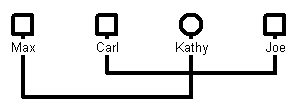 Wrong genogram layout for Kathy having three husbands
Wrong genogram layout for Kathy having three husbands
The idea here is to show Kathy had three husbands, however there is a
problem with the figure: which husband is first, second and third? The
problem is that rule #3
has not been followed. By looking carefully at this genogram, we get a
completely different outcome.
- Joe and Kathy have never been together because it breaks rule #1.
- Carl was Kathy's first husband (rule #1 and rule #3).
- Carl left Kathy and decided to live with Joe (rule #3).
- Max was Kathy's second husband (rule #1 and rule #3).
Possible Genogram Ambiguity
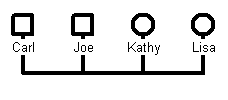 Possible ambiguity rule #2
Possible ambiguity rule #2
 No possible ambiguity (solution 1)
No possible ambiguity (solution 1)
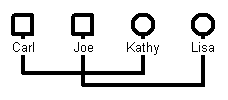 No possible ambiguity (solution 2)
No possible ambiguity (solution 2)
In this figure, we have two males and two females. At first, it would appear
this layout is ambiguous, however applying
rule #2 (male-female relationship), we can observe Joe and Kathy are
together. Since Joe and Kathy are together, it follows Carl is Kathy's
second husband since Carl is further away from Kathy. Similarly, Lisa is
Joe's second wife. The best solution however is to place the
individuals in a different layout so there is no possible ambiguity for the
inexperienced reader.
Resolving Genogram Ambiguity
Let's add one more partner to the genogram. In this situation, it is impossible to determine the family relationships.
 Genogram Ambiguity: Too Many Partners
Genogram Ambiguity: Too Many Partners
At first glance, this sample genogram could be the life of Max, having Carl
as his first partner, then Kathy, then Joe and then Lisa. Let's analyze this
sample genogram a bit more deeper.
Rule #1 tells us that Kathy and Joe cannot be together. By applying
rule #2 (male-female relationship), we notice two couples: Carl &
Kathy and Joe & Lisa. There are two problems: Who is Max's partner and the
line between Kathy and Joe represent what family. This genogram is confusing
and it is impossible to determine the family relationships The best thing is
to re-arrange the layout so there is no more ambiguity.
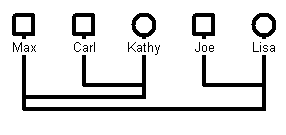 Resolving Ambiguity (scenario 1)
Resolving Ambiguity (scenario 1)
 Resolving Ambiguity (scenario 2)
Resolving Ambiguity (scenario 2)
The first scenario is the story of Carl & Kathy and Joe & Lisa (rule
#1 and rule #2). Both
couples separated, Kathy had Max as her second husband and Lisa had Max as
her second husband (rule #3).
Max's first wife was Kathy and his second wife was Lisa (rule #3).
The second scenario is the story of Max. Nothing more to say here.
Complex Genograms
So far, we have ignored rule #4 (the children). What if each couple had
children? Let's have the genogram of scenario #1 with a few children.
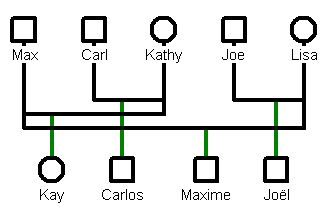 Genogram of Scenario #1 with Children
Genogram of Scenario #1 with Children
In this scenario, each couple has one child. For clarity, each child link
has been colored in green. If more children are present, a split of the
family object must be performed as displayed below:
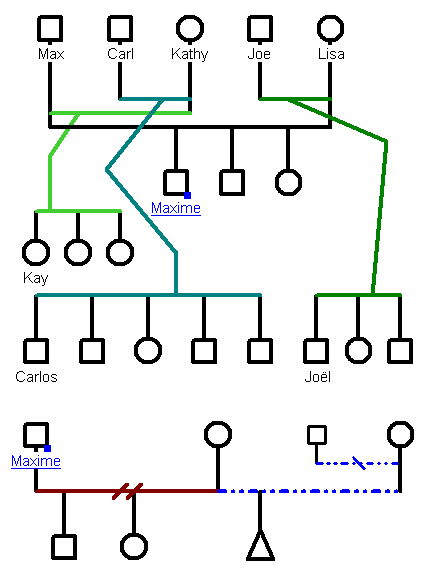 Genogram of Scenario #1 with more children
Genogram of Scenario #1 with more children
This time, each family object has been colored to highlight the splitting.
Each child having a name is the oldest of his family. To make this genogram
a bit more interesting, we made Maxime parent of a few children. There is
not enough room for this, so a hyperlink was created. The hyperlink allows a
genogram to be split while preserving its pedigree links. The hyperlink may
be placed anywhere on the genogram and/or to another GenoMap. As we can
observe, Maxime had two children with his first wife before divorcing.
Maxime is cohabiting with his girlfriend, who is pregnant with a little boy.
From the drawing, it is impossible to know if the pregnancy (triangle
symbol) represents a male or a female, however GenoPro can record the gender
of the fetus. If you open file SampleGenogram.gno
and double click on the triangle symbol, you will see it's a boy!
Previous: Genogram symbols
Next: How to create a genogram walkthrough